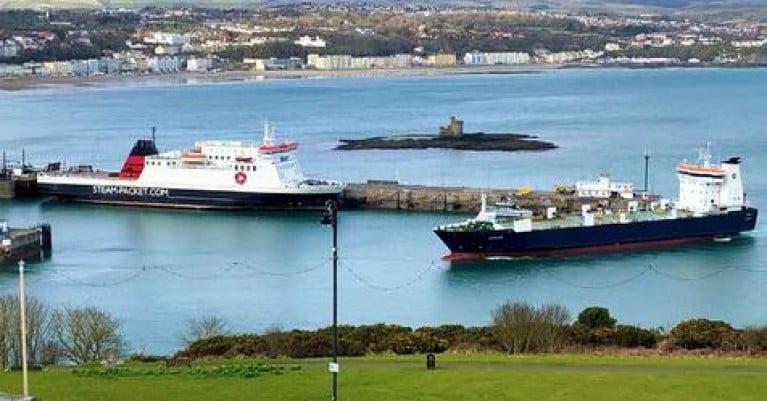Displaying items by tag: Freight ferry
Freight Ferry Had 'No Flames' During Incident Which Forced Stena Line Ship Return to Belfast Port
A freight ferry according to Stena Line said there was no fire on board its ship which was forced to make a return to Belfast Port on Tuesday evening.
The incident led to fire crews attending the scene in the port and the ferry company added the vessel made its return as a precaution.
The freight ro-ro vessel Stena Scotia which was bound for Heysham in Lancashire, had departed Belfast at 8.30pm with 22 crew and 10 truck drivers onboard. However, the 13,017 gross tonnage ship returned to the port at around 9pm after it reported that a freight trailer on a vehicle deck was "heating with a small amount of smoke".
Stena said smoke was seen to be coming from an overheating trailer which was believed to have contained oxidising aluminium.
Crew members of the Isle of Man registered ro-ro which sails on the 8-hour Irish Sea route responded by cooling the trailer with hoses.
For more ITV News reports.
Dr Alex Allinson, the Isle of Man's Treasury Minister says he doesn’t know how often the ro-ro freight ferry Arrow is leased out, but he has no concerns over it being available when the Steam Packet needs it.
The Isle of Man Steam Packet’s purchase of the backup / relief freighter MV Arrow for €9m, was due to be completed this week.
Asked in the House of Keys about the Douglas-Heysham route's reserve ship's availability by Jason Moorhouse (Arbory, Castletown and Malew), Dr Allinson said: ‘The information requested is not held by Treasury and relates to the operations of the Isle of Man’s Steam Packet Company, a now government-owned entity operating at an arm’s-length basis.’
That rather set the tone in the Keys for the short exchange, with Dr Allinson continuing to say the issues raised about the 84 trailer-unit capacity freighter were ones for the Douglas based ferry operator and its board.
More from Isle of Man Today on the Arrow.
Afloat adds the freight ferry when not required during busy times such as the TT Races, has been sub-chartered to operators in Scotland and the Channel Islands.
Isle of Man Freight Ferry Departs Heysham after Ropax Had to Leave Early
The Isle of Man Steam Packet Company had to add an extra freight sailing after silt caused issues for the ferry Ben-my-Chree at Heysham.
The ferry operator according to Manx Radio, had to change its sailing times over the last couple of days because of problems at the Lancashire port.
The early departure overnight meant very limited freight was able to make the crossing.
As a result, the Arrow was brought into service and left Heysham at 4am with the freight, including the newspapers, which are expected into shops around three hours later than usual.
Former Irish Sea Freight Ferry Returns to Familiar Waters
#FerryNews - A former Irish Sea freightferry has in recent days returned to familiar duties running between Northern Ireland and England, writes Jehan Ashmore.
The 120 trailer-unit Stena Scotia entered service on the Belfast-Heysham route to cover a sister, Stena Hibernia which went off service for dry-docking at Harland & Wolff.
Up until 2013, Stena Scotia had operated the Irish Sea route.The 13,017grt vessel had sailed last week from Killingholme on the Humber Estuary, from where Stena Line operate a freight-only service to Hoek van Holland.
Prior to the Irish Sea transfer, Stena Scotia's role on the North Sea was to permit the Dutch route's routine vessel Stena Transit to undergo dry-docking. Otherwise, Stena Scotia also operates from the same Humber port but to Rotterdam.
Earlier in the summer Afloat reported on a pair of larger Belfast-Heysham chartered-in vessels each with a 151 trailer capacity. They are the Stena Precision and Stena Performance which are to be returned to owners Seatruck for operations on the Warrenpoint-Heysham route.





























































